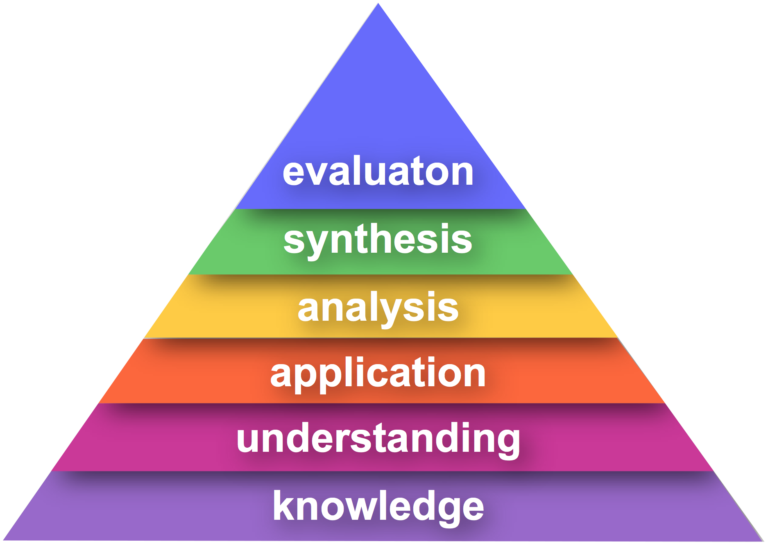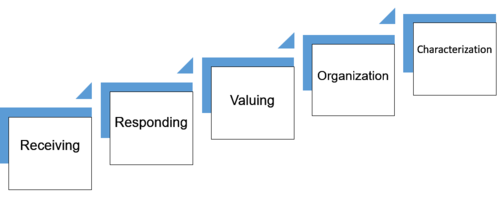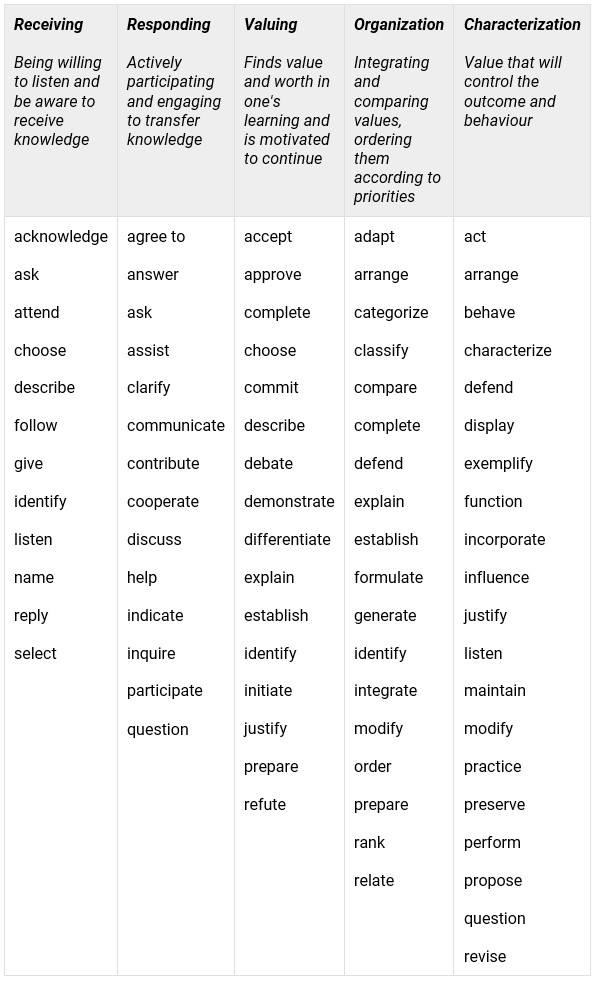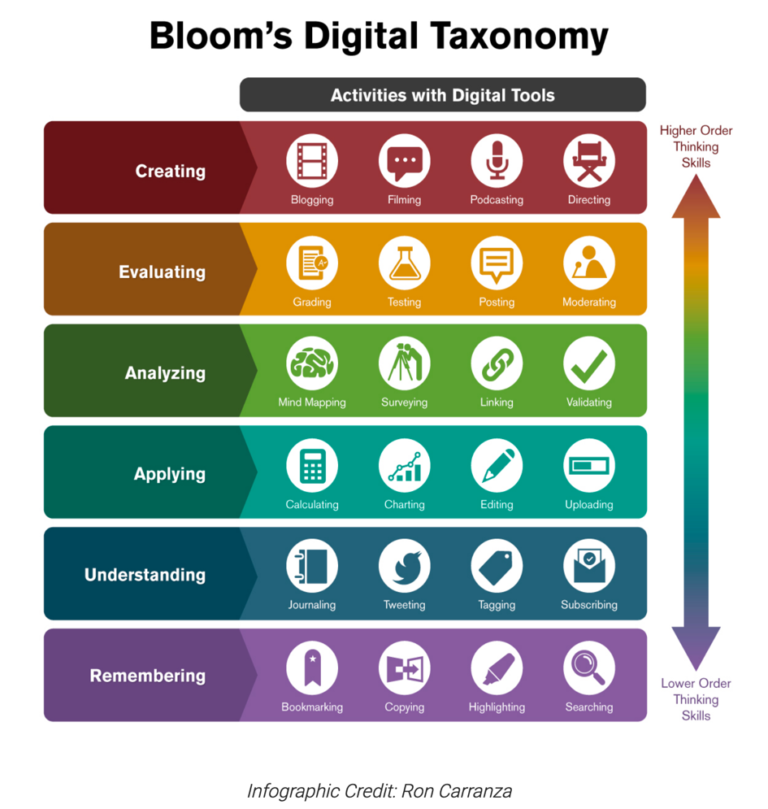/*! elementor – v3.5.4 – 23-01-2022 */
.elementor-heading-title{padding:0;margin:0;line-height:1}.elementor-widget-heading .elementor-heading-title[class*=elementor-size-]>a{color:inherit;font-size:inherit;line-height:inherit}.elementor-widget-heading .elementor-heading-title.elementor-size-small{font-size:15px}.elementor-widget-heading .elementor-heading-title.elementor-size-medium{font-size:19px}.elementor-widget-heading .elementor-heading-title.elementor-size-large{font-size:29px}.elementor-widget-heading .elementor-heading-title.elementor-size-xl{font-size:39px}.elementor-widget-heading .elementor-heading-title.elementor-size-xxl{font-size:59px}
Cross-Reference Learning Design with Bloom’s Taxonomy
Here you can find some suggested learning activities and assessments grouped by the main verbs of each of the domains Bloom’s encompasses – Affective, Cognitive and Psychomotor. Scroll down to better envision how these may look in your context.
/*! elementor – v3.5.4 – 23-01-2022 */
.elementor-widget-image{text-align:center}.elementor-widget-image a{display:inline-block}.elementor-widget-image a img[src$=”.svg”]{width:48px}.elementor-widget-image img{vertical-align:middle;display:inline-block} 

/*! elementor – v3.5.4 – 23-01-2022 */
.elementor-toggle{text-align:left}.elementor-toggle .elementor-tab-title{font-weight:700;line-height:1;margin:0;padding:15px;border-bottom:1px solid #d4d4d4;cursor:pointer;outline:none}.elementor-toggle .elementor-tab-title .elementor-toggle-icon{display:inline-block;width:1em}.elementor-toggle .elementor-tab-title .elementor-toggle-icon svg{-webkit-margin-start:-5px;margin-inline-start:-5px;width:1em;height:1em}.elementor-toggle .elementor-tab-title .elementor-toggle-icon.elementor-toggle-icon-right{float:right;text-align:right}.elementor-toggle .elementor-tab-title .elementor-toggle-icon.elementor-toggle-icon-left{float:left;text-align:left}.elementor-toggle .elementor-tab-title .elementor-toggle-icon .elementor-toggle-icon-closed{display:block}.elementor-toggle .elementor-tab-title .elementor-toggle-icon .elementor-toggle-icon-opened{display:none}.elementor-toggle .elementor-tab-title.elementor-active{border-bottom:none}.elementor-toggle .elementor-tab-title.elementor-active .elementor-toggle-icon-closed{display:none}.elementor-toggle .elementor-tab-title.elementor-active .elementor-toggle-icon-opened{display:block}.elementor-toggle .elementor-tab-content{padding:15px;border-bottom:1px solid #d4d4d4;display:none}@media (max-width:767px){.elementor-toggle .elementor-tab-title{padding:12px}.elementor-toggle .elementor-tab-content{padding:12px 10px}}
Affective Domain
*Scroll down to review example assessments and activities to better evaluate alignment in course outlines.
Affective Domain: emotional response concerning one’s attitudes, values and appreciation for motivation in learning.


This is an embedded Microsoft Office presentation, powered by Office.
This is an embedded Microsoft Office presentation, powered by Office.
Sample Assessments
/*! elementor-pro – v3.6.0 – 31-01-2022 */
.elementor-slides .swiper-slide-bg{background-size:cover;background-position:50%;background-repeat:no-repeat;min-width:100%;min-height:100%}.elementor-slides .swiper-slide-inner{background-repeat:no-repeat;background-position:50%;position:absolute;top:0;left:0;bottom:0;right:0;padding:50px;margin:auto}.elementor-slides .swiper-slide-inner,.elementor-slides .swiper-slide-inner:hover{color:#fff;display:-webkit-box;display:-ms-flexbox;display:flex}.elementor-slides .swiper-slide-inner .elementor-background-overlay{position:absolute;z-index:0;top:0;bottom:0;left:0;right:0}.elementor-slides .swiper-slide-inner .elementor-slide-content{position:relative;z-index:1;width:100%}.elementor-slides .swiper-slide-inner .elementor-slide-heading{font-size:35px;font-weight:700;line-height:1}.elementor-slides .swiper-slide-inner .elementor-slide-description{font-size:17px;line-height:1.4}.elementor-slides .swiper-slide-inner .elementor-slide-description:not(:last-child),.elementor-slides .swiper-slide-inner .elementor-slide-heading:not(:last-child){margin-bottom:30px}.elementor-slides .swiper-slide-inner .elementor-slide-button{border:2px solid #fff;color:#fff;background:transparent;display:inline-block}.elementor-slides .swiper-slide-inner .elementor-slide-button,.elementor-slides .swiper-slide-inner .elementor-slide-button:hover{background:transparent;color:inherit;text-decoration:none}.elementor–v-position-top .swiper-slide-inner{-webkit-box-align:start;-ms-flex-align:start;align-items:flex-start}.elementor–v-position-bottom .swiper-slide-inner{-webkit-box-align:end;-ms-flex-align:end;align-items:flex-end}.elementor–v-position-middle .swiper-slide-inner{-webkit-box-align:center;-ms-flex-align:center;align-items:center}.elementor–h-position-left .swiper-slide-inner{-webkit-box-pack:start;-ms-flex-pack:start;justify-content:flex-start}.elementor–h-position-right .swiper-slide-inner{-webkit-box-pack:end;-ms-flex-pack:end;justify-content:flex-end}.elementor–h-position-center .swiper-slide-inner{-webkit-box-pack:center;-ms-flex-pack:center;justify-content:center}body.rtl .elementor-widget-slides .elementor-swiper-button-next{left:10px;right:auto}body.rtl .elementor-widget-slides .elementor-swiper-button-prev{right:10px;left:auto}.elementor-slides-wrapper div:not(.swiper-slide)>.swiper-slide-inner{display:none}@media (max-width:767px){.elementor-slides .swiper-slide-inner{padding:30px}.elementor-slides .swiper-slide-inner .elementor-slide-heading{font-size:23px;line-height:1;margin-bottom:15px}.elementor-slides .swiper-slide-inner .elementor-slide-description{font-size:13px;line-height:1.4;margin-bottom:15px}}
Receiving• Feedback forms
• Fill-in-the-blanks
• Knowledge survey
• List
• Match
• Memory tests
• One-minute paper
• Qualitative interviews
• Test activities (recall and verbalize reactions)
• Write summary on key points of presentation
Responding• Answer questions
• Ability to follow procedures
• Critical questioning
• Feedback and peer evaluation
• One-minute paper
• Questionnaires
• Willingness to participate
Valuing• Attendance
• Neatness and carefulness (with minimal errors) of submitted work
• Meet deadlines
• Proposals of new plans
• Questionnaire
• Rating scale
• Reflection piece
• Report on extra-curricular activities
• Ungraded paperOrganization• Develop realistic aspirations
• Prioritize time to meet goals
• Focus groups
• Questionnaires
• Ability to solve new problems
Characterization• Criteria for group projects
• Self-evaluation
• SMART goals
Previous
Next
Sample Learning Activities
Receiving• Attend focus groups
• Listen as audience to a presentation
• Read articles/papers/ textbooks
• Watch a video
Responding• Active participation in classroom activities
• Brainstorm ideas
• Group discussions
• Present in front of audience
• Problem solving activities
• Role-play
• Written assignments (essays, reports etc.)
Valuing• Debates
• Opinionated writing piece
• Reflection exercises (reflection paper)
• Self-report
Organization• Analyze and contrast (with charts, tables, Venn diagrams)
• Concept map (report formal and informal experiences and identify skills)
Characterization• Critical reflection
• Group projects
• Self-report goals (personally and academically)
Previous
Next
/*! elementor – v3.5.4 – 23-01-2022 */
@media (min-width:768px){.elementor-widget-icon-box.elementor-position-left .elementor-icon-box-wrapper,.elementor-widget-icon-box.elementor-position-right .elementor-icon-box-wrapper{display:-webkit-box;display:-ms-flexbox;display:flex}.elementor-widget-icon-box.elementor-position-left .elementor-icon-box-icon,.elementor-widget-icon-box.elementor-position-right .elementor-icon-box-icon{display:-webkit-inline-box;display:-ms-inline-flexbox;display:inline-flex;-webkit-box-flex:0;-ms-flex:0 0 auto;flex:0 0 auto}.elementor-widget-icon-box.elementor-position-right .elementor-icon-box-wrapper{text-align:right;-webkit-box-orient:horizontal;-webkit-box-direction:reverse;-ms-flex-direction:row-reverse;flex-direction:row-reverse}.elementor-widget-icon-box.elementor-position-left .elementor-icon-box-wrapper{text-align:left;-webkit-box-orient:horizontal;-webkit-box-direction:normal;-ms-flex-direction:row;flex-direction:row}.elementor-widget-icon-box.elementor-position-top .elementor-icon-box-img{margin:auto}.elementor-widget-icon-box.elementor-vertical-align-top .elementor-icon-box-wrapper{-webkit-box-align:start;-ms-flex-align:start;align-items:flex-start}.elementor-widget-icon-box.elementor-vertical-align-middle .elementor-icon-box-wrapper{-webkit-box-align:center;-ms-flex-align:center;align-items:center}.elementor-widget-icon-box.elementor-vertical-align-bottom .elementor-icon-box-wrapper{-webkit-box-align:end;-ms-flex-align:end;align-items:flex-end}}@media (max-width:767px){.elementor-widget-icon-box .elementor-icon-box-icon{margin-left:auto!important;margin-right:auto!important;margin-bottom:15px}}.elementor-widget-icon-box .elementor-icon-box-wrapper{text-align:center}.elementor-widget-icon-box .elementor-icon-box-title a{color:inherit}.elementor-widget-icon-box .elementor-icon-box-content{-webkit-box-flex:1;-ms-flex-positive:1;flex-grow:1}.elementor-widget-icon-box .elementor-icon-box-description{margin:0}
Affective Domain
*Scroll down to review example activities and assessments.
Affective Domain: emotional response concerning one’s attitudes, values and appreciation for motivation in learning.

1) Sample Learning Activities
Receiving• Attend focus groups
• Listen as audience to a presentation
• Read articles/papers/ textbooks
• Watch a video
Responding• Active participation in classroom activities
• Brainstorm ideas
• Group discussions
• Present in front of audience
• Problem solving activities
• Role-play
• Written assignments (essays, reports etc.)
Valuing• Debates
• Opinionated writing piece
• Reflection exercises (reflection paper)
• Self-report
Organization• Analyze and contrast (with charts, tables, Venn diagrams)
• Concept map (report formal and informal experiences and identify skills)
Characterization• Critical reflection
• Group projects
• Self-report goals (personally and academically)
Previous
Next
/*! elementor – v3.5.4 – 23-01-2022 */
.elementor-widget-divider{–divider-border-style:none;–divider-border-width:1px;–divider-color:#2c2c2c;–divider-icon-size:20px;–divider-element-spacing:10px;–divider-pattern-height:24px;–divider-pattern-size:20px;–divider-pattern-url:none;–divider-pattern-repeat:repeat-x}.elementor-widget-divider .elementor-divider{display:-webkit-box;display:-ms-flexbox;display:flex}.elementor-widget-divider .elementor-divider__text{font-size:15px;line-height:1;max-width:95%}.elementor-widget-divider .elementor-divider__element{margin:0 var(–divider-element-spacing);-ms-flex-negative:0;flex-shrink:0}.elementor-widget-divider .elementor-icon{font-size:var(–divider-icon-size)}.elementor-widget-divider .elementor-divider-separator{display:-webkit-box;display:-ms-flexbox;display:flex;margin:0;direction:ltr}.elementor-widget-divider–view-line_icon .elementor-divider-separator,.elementor-widget-divider–view-line_text .elementor-divider-separator{-webkit-box-align:center;-ms-flex-align:center;align-items:center}.elementor-widget-divider–view-line_icon .elementor-divider-separator:after,.elementor-widget-divider–view-line_icon .elementor-divider-separator:before,.elementor-widget-divider–view-line_text .elementor-divider-separator:after,.elementor-widget-divider–view-line_text .elementor-divider-separator:before{display:block;content:””;border-bottom:0;-webkit-box-flex:1;-ms-flex-positive:1;flex-grow:1;border-top:var(–divider-border-width) var(–divider-border-style) var(–divider-color)}.elementor-widget-divider–element-align-left .elementor-divider .elementor-divider-separator>.elementor-divider__svg:first-of-type{-webkit-box-flex:0;-ms-flex-positive:0;flex-grow:0;-ms-flex-negative:100;flex-shrink:100}.elementor-widget-divider–element-align-left .elementor-divider-separator:before{content:none}.elementor-widget-divider–element-align-left .elementor-divider__element{margin-left:0}.elementor-widget-divider–element-align-right .elementor-divider .elementor-divider-separator>.elementor-divider__svg:last-of-type{-webkit-box-flex:0;-ms-flex-positive:0;flex-grow:0;-ms-flex-negative:100;flex-shrink:100}.elementor-widget-divider–element-align-right .elementor-divider-separator:after{content:none}.elementor-widget-divider–element-align-right .elementor-divider__element{margin-right:0}.elementor-widget-divider:not(.elementor-widget-divider–view-line_text):not(.elementor-widget-divider–view-line_icon) .elementor-divider-separator{border-top:var(–divider-border-width) var(–divider-border-style) var(–divider-color)}.elementor-widget-divider–separator-type-pattern{–divider-border-style:none}.elementor-widget-divider–separator-type-pattern.elementor-widget-divider–view-line .elementor-divider-separator,.elementor-widget-divider–separator-type-pattern:not(.elementor-widget-divider–view-line) .elementor-divider-separator:after,.elementor-widget-divider–separator-type-pattern:not(.elementor-widget-divider–view-line) .elementor-divider-separator:before,.elementor-widget-divider–separator-type-pattern:not([class*=elementor-widget-divider–view]) .elementor-divider-separator{width:100%;min-height:var(–divider-pattern-height);-webkit-mask-size:var(–divider-pattern-size) 100%;mask-size:var(–divider-pattern-size) 100%;-webkit-mask-repeat:var(–divider-pattern-repeat);mask-repeat:var(–divider-pattern-repeat);background-color:var(–divider-color);-webkit-mask-image:var(–divider-pattern-url);mask-image:var(–divider-pattern-url)}.elementor-widget-divider–no-spacing{–divider-pattern-size:auto}.elementor-widget-divider–bg-round{–divider-pattern-repeat:round}.rtl .elementor-widget-divider .elementor-divider__text{direction:rtl}
2) Sample Assessments
Receiving• Feedback forms
• Fill-in-the-blanks
• Knowledge survey
• List
• Match
• Memory tests
• One-minute paper
• Qualitative interviews
• Test activities (recall and verbalize reactions)
• Write summary on key points of presentation
Responding• Answer questions
• Ability to follow procedures
• Critical questioning
• Feedback and peer evaluation
• One-minute paper
• Questionnaires
• Willingness to participate
Valuing• Attendance
• Neatness and carefulness (with minimal errors) of submitted work
• Meet deadlines
• Proposals of new plans
• Questionnaire
• Rating scale
• Reflection piece
• Report on extra-curricular activities
• Ungraded paperOrganization• Develop realistic aspirations
• Prioritize time to meet goals
• Focus groups
• Questionnaires
• Ability to solve new problems
Characterization• Criteria for group projects
• Self-evaluation
• SMART goals
Previous
Next
Cognitive Domain
*Scroll down to review example activities and then assessments.
Cognitive Domain: intellectual skills and abilities required for learning, thinking critically, and problem solving.

1) Sample Learning Activities
Remember• Flashcards
• Highlight key words
• List
• Memory activities
• Reading materials
• Watching presentations and videos
Understand• Case studies
• Concept map
• Demonstrations
• Diagrams
• Flowcharts
• Group discussions
• Mind map
• Matrix activity
• Play/sketches
• Summarize
• Think-pair-share
Apply• Calculate
• Case studies
• Concept map
• Creating examples
• Demonstrations
• Flipped classroom
• Gallery walk
• Gamification
• Group work
• Lab experiments
• Map
• Problem-solving tasks
• Short answers
• Role play Analyze• Case studies
• Compare and contrast (with charts, tables, Venn diagrams)
• Concept map
• Debates
• Discussions
• Flowchart
• Graph
• Group investigation
• Mind map
• Questionnaires
• Report/survey
• Think-pair-share
Evaluate• Debates
• Compare and contrast (with charts, tables, Venn diagrams)
• Concept map
• Journal
• Pros and cons list
• Mind map
• Review paper Create• Brainstorm
• Decision-making tasks
• Develop and describe new solutions or plans
• Design project
• Performances
• Presentations
• Research projects
• Written assignment
Previous
Next
2) Sample Assessments
Remember• Clicker questions
• Fill in the blanks
• Label
• Match
• Multiple choice
• Quizzes
• True and false questions Understand• Concept map
• Create a summary
• Essay
• Diagrams
• Infographics
• Matrix activity
• One-minute paper
• Presentation
• Provide examples
• Quizzes
• Short answers
Apply• Discussion board post
• E-portfolio
• Lab reports
• One-minute paper
• Presentation
• Problem-solving tasks
• Short answersAnalyze• Analysis paper
• Case study
• Evaluation criteria
• Critique hypothesis, procedures etc.
• Muddiest point
• One-minute paper
• Research paper
• Review paper Evaluate• Argumentative or persuasive essay
• Debates
• Discussions
• Presentation
• Provide alternative solutions
• Report Create• Develop criteria to evaluate product or solution
• Grant proposal
• Outline alternative solutions
• Research proposal
Previous
Next
University of Waterloo. (2019, April 17). Bloom’s taxonomy learning activities and assessments. Centre for Teaching Excellence. https://uwaterloo.ca/centre-for-teaching-excellence/resources/teaching-tips/blooms-taxonomy-learning-activities-and-assessments
Psychomotor Domain
Psychomotor Domain: ability to use motor skills which includes physical movement, reflex and coordination to develop techniques in execution, in accuracy, and time.

Sample Activities & Assessments
Set• Knows and acts upon a sequence of steps in a manufacturing process
• Recognize one’s abilities and limitations
• Shows desire to learn a new process (motivation)
Guided Response• Performs a mathematical equation as demonstrated
• Follows instructions to build a model
• Responds hand-signals of instructor while learning to operate a forklift
Mechanism• Use a personal computer
• Repair a leaking faucet
• Drive a carComplex Overt Response• Maneuvers a car into a tight parallel parking spot
• Operates a computer quickly and accurately
• Displays competence while playing the pianoAdaptation• Responds effectively to unexpected experiences
• Modifies instruction to meet the needs of the learners
• Perform a task with a machine that it was not originally intended for (machine is not damaged and there is no danger in performing the new task)
Origination• Constructs a new theory
• Develops a new and comprehensive training programming
• Creates a new gymnastic routine
Previous
Next
Arkansas State University. (n.d.). Bloom’s Revised Taxonomy: Cognitive, Affective, and Psychomotor. Arkansas State. https://www.astate.edu/dotAsset/7a3b152c-b73a-45d6-b8a3-7ecf7f786f6a.pdf
Digital Focus
Use the following infographic for some suggestions on how digital tools and environments can be viewed in relation to the levels of the Taxonomy.
*Click the image to enlarge.

University of British Columbia. (n.d.). Step 1.5: Selecting technologies for learning. Office of the Provost and Vice-President Academic: UBC’s Okanagan Campus. https://provost.ok.ubc.ca/initiatives/online-transition/faculty-resources/learning-design-2/step1/step1-tech-learning/
